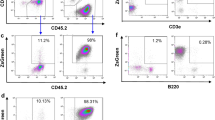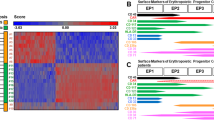Abstract
Erythroleukaemia, until now defined by morphological criteria, has been observed in mice infected with several distinct virological entities, including the polycythaemia-inducing strains of Friend virus complex (FV-P)1,2, the anaemia-inducing strains of Friend3 and Rauscher4,5 virus complex (FV-A and RV-A, respectively) and various helper-independent virus isolates derived from the FV-A6 or RV-A7 complexes. Whereas erythroleukaemia develops rapidly (within 2–3 weeks) in mice infected with any strain of FV or RV, the helper-independent virus alone is pathogenic in mice only if they are infected neonatally6,7. We now describe how two biological markers can be used to distinguish among the otherwise confusing array of virus-induced erythroleukaemias in mice. The evidence suggests that there are three different classes of this disease: (1) those (S+E+) from which both defective spleen focus-forming virus (SFFV) and erythropoietin-independent, erythroid colony forming units (CFU-EI) can be recovered, (2) those (S+E−) from which only SFFV (but not CFU-EI) can be recovered, and (3) those (S−E−) from which neither SFFV nor CFU-EI can be recovered. There is a consistent association between the type of virus used to induce the erythroleukaemia and the class of the disease induced.
This is a preview of subscription content, access via your institution
Access options
Subscribe to this journal
Receive 51 print issues and online access
$199.00 per year
only $3.90 per issue
Buy this article
- Purchase on Springer Link
- Instant access to full article PDF
Prices may be subject to local taxes which are calculated during checkout
Similar content being viewed by others
References
Stephenson, J. R., Axelrad, A. A. & McLeod, D. L. J. natn. Cancer Inst. 48, 531–539 (1972).
Steeves, R. A. J. natn. Cancer Inst. 54, 289–297 (1975).
Zajdela, R. Bull. Cancer 49, 351–373 (1962).
Siegel, B. V., Weaver, W. J. & Koler, R. D. Nature 201, 1042–1043 (1964).
Cox, K. O. & Keast, D. J. natn. Cancer Inst. 50, 941–946 (1973).
Troxler, D. H. & Scolnick, E. M. Virology 85, 17–27 (1978).
Weitz-Hamburger, A. et al. Cancer Res. 33, 104–111 (1973).
Friend, C. J. exp. med. 105, 307–318 (1957).
Metcalf, D., Furth, J. & Buffett, R. F. Cancer Res. 19, 52–59 (1959).
Tambourin, P. & Wendling, F. Nature new Biol. 234, 230–233 (1971).
Fieldsteel, A. H., Dawson, P. J. & Bostick, W. L. Cancer Res. 23, 355–362 (1963).
Mirand, E. A. et al. Proc. Soc. exp. Biol. Med. 127, 900–904 (1968).
Rauscher, F. J. J. natn. Cancer Inst. 29, 515–543 (1962).
Kirsten, W. H. & Mayer, L. A. J. natn. Cancer Inst. 39, 311–335 (1967).
Pope, J. H. Aust. J. exp. Biol. med. Sci. 41, 349–362 (1962).
Dawson, P. J., Dresler, S. L. & Fieldsteel, A. H. Cancer Res. 39, 1611–1615 (1979).
Fieldsteel, A. H., Kurahara, C. & Dawson, P. J. Nature 223, 1274 (1969).
Eckner, R. J. & Steeves, R. A. Nature new Biol. 229, 241–243 (1971).
Bentvelzen, P., Aarssen, A. M. & Brinkhof, J. Nature new Biol. 239, 122–123 (1972).
Axelrad, A. A. & Steeves, R. A. Virology 24, 513–518 (1964).
Pluznik, D. H. & Sachs, L. J. natn. Cancer Inst. 35, 535–546 (1964).
Troxler, D. H. et al. Virology 76, 602–615 (1977).
Troxler, D. H. et al. Proc. natn. Acad. Sci. U.S.A. 74, 4671–4675 (1977).
Troxler, D. H. et al. Virology 102, 28–45 (1980).
Boiron, M. et al. J. natn. Cancer Inst. 35, 865–884 (1965).
Dunn, T. B. & Green, A. W. J. natn. Cancer Inst. 36, 987–1001 (1966).
Liao, S. K. & Axelrad, A. A. Int. J. Cancer 15, 467–482 (1975).
Ostertag, W. et al. J. Virol. 33, 573–582 (1980).
Golde, D. W. et al. Proc. natn. Acad. Sci. U.S.A. 76, 962–966 (1979).
Mirand, E. A. in Regulation of Erythropoiesis (eds Gordon, A. S., Condorelli, M. Peschle, C.) 333–341 (Il Ponte, Milan, 1971).
Steinheider, G., Seidel, H. J. & Kreja, L. Experientia 35, 1173–1175 (1979).
Morse, B. et al. Blood 51, 623–632 (1978).
Oliff, A. I. et al. J. Virol. 33, 475–486 (1980).
Sher, C. D., Scolnick, E. M. & Siegler, R. Nature 256, 225–226 (1975).
Dawson, R. J., Rose, W. M. & Fieldsteel, A. H. Br. J. Cancer 20, 114–121 (1966).
Steeves, R. A. et al. J. natn. Cancer Inst. 46, 1209–1217 (1971).
Ishimoto, A. & Maeda, M. J. natn. Cancer Inst. 44, 361–368 (1970).
Author information
Authors and Affiliations
Rights and permissions
About this article
Cite this article
Anand, R., Steeves, R. How many types of erythroleukaemia are induced by retroviruses in mice?. Nature 286, 615–617 (1980). https://doi.org/10.1038/286615a0
Received:
Accepted:
Issue Date:
DOI: https://doi.org/10.1038/286615a0
Comments
By submitting a comment you agree to abide by our Terms and Community Guidelines. If you find something abusive or that does not comply with our terms or guidelines please flag it as inappropriate.



